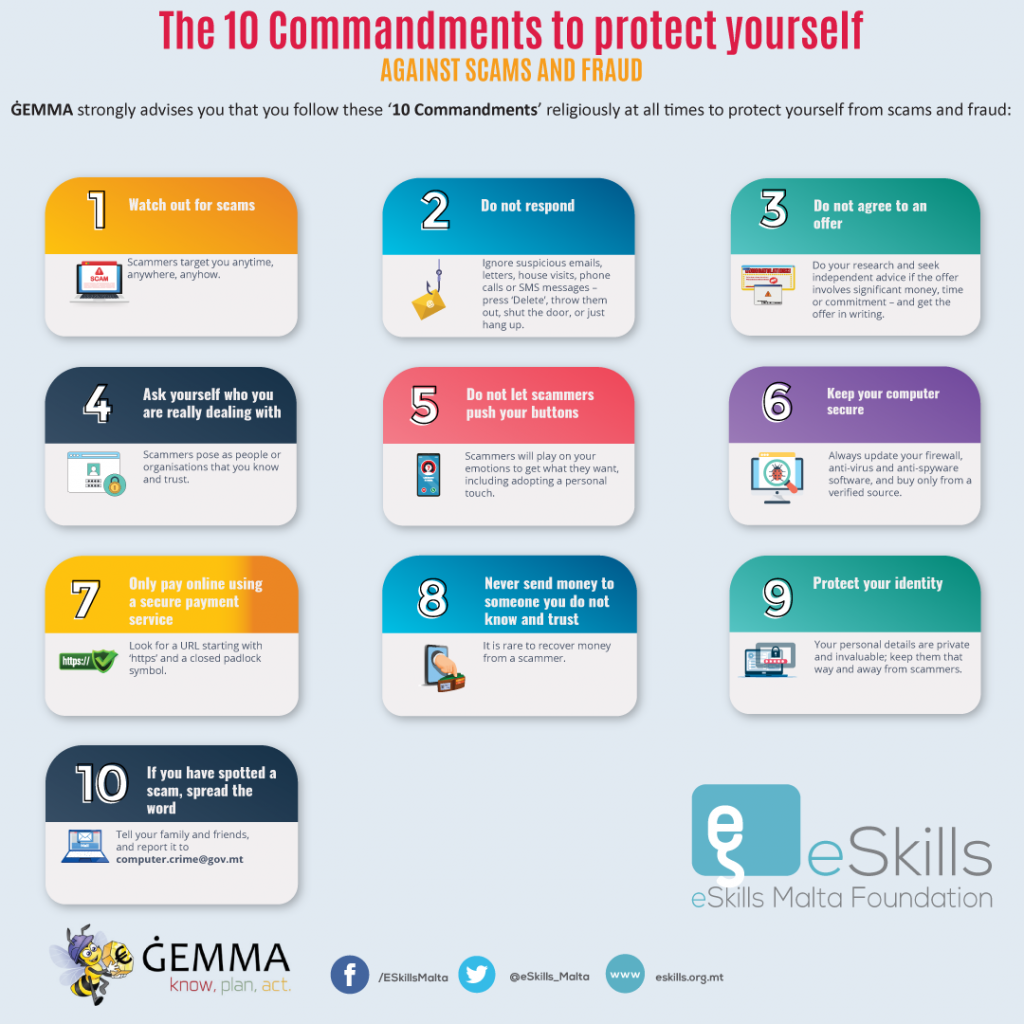Do you know how a scam works?
Recently we have seen a spate of scams in Malta – including phishing, romance fraud and business email fraud. Newspapers have reported that one business lost nearly €90,000 as a result of a business email fraud and over €100,000 have been defrauded from persons scammed by the Maltapost phishing scam.
In the summer of last year, ĠEMMA (gemma.gov.mt) and the eSkills Malta Foundation (eskills.org.mt) signed a strategic partnership to disseminate knowledge on digital financial capability. Fraud and scams is such one financial capability. Jointly we have issued 4 e-books on scams and fraud (https://gemma.gov.mt/ebook-download-page/) and Infographics (https://gemma.gov.mt/resources/infographics/) on tips on how to protect yourself with regard to over 30 different scams and frauds. Both ĠEMMA and the eSkills Malta Foundation have been disseminating these over their respective social media channels.
Most scams follow the same pattern – understand this pattern and it will be easier to spot. The way a scam works is described here.
The Scammer’s approach: A scammer will approach you with a story designed to make you believe a lie. They target your emotions and behaviour. Common examples might be the chance to make money, to find a partner, to help somebody in need. Invariably the scammer will disguise themselves as a person of authority and using familiar branding. The scammer will use social media, phone calls or SMS.
The scammer’s tools are designed to get someone to lower their defences, build trust in the story and act quickly or irrationally and proceed to the final stage – sending the money or providing personal information. The scammer tries to create a sense of urgency, use high pressure sales tactics such as offering a limited offer, that prices will rise, or that the market will change, and the opportunity will be lost.
They will also have all the hallmarks of a real business using glossy brochures with technical industry jargon backed up with office fronts, call centres and professional websites. By using one’s personal details they make the scam appear legitimate. They will use counterfeit and official-looking documents – documents that appear to have government approval or are filled with legal jargon can give a scam an air of authority.
At the point of contact they will try to ask for money. Scammers will have their preferred money transfer method. Some of the methods may be wire transfer, credit / debit card, bank transfer, cryptocurrencies such as Bitcoin.

In addition to these 10 Commandments, one should keep in mind the following:
It is NOT always true that companies, businesses and enterprises are always legitimate.
It is NOT always true that all websites are legitimate. It is quite easy and cheap to set up a website. An enterprise’s website can be easily copied by scammers who will want to trick you into believing it to be genuine.
It is NOT always true that scams involve large amounts of money. Sometimes scammers target many people and try to get a small amount of money from many people.
It is NOT always true that scams are always about money. Some scams are aimed at stealing personal information about you.
If one believes that they have uncovered a scam or you were the target victim of one, ĠEMMA advises you to report this. Do not let the scammer get away with it. Remember that there are vulnerable people who may not have the knowledge you have and may be at a high risk of being scammed unless the scam is stopped.

